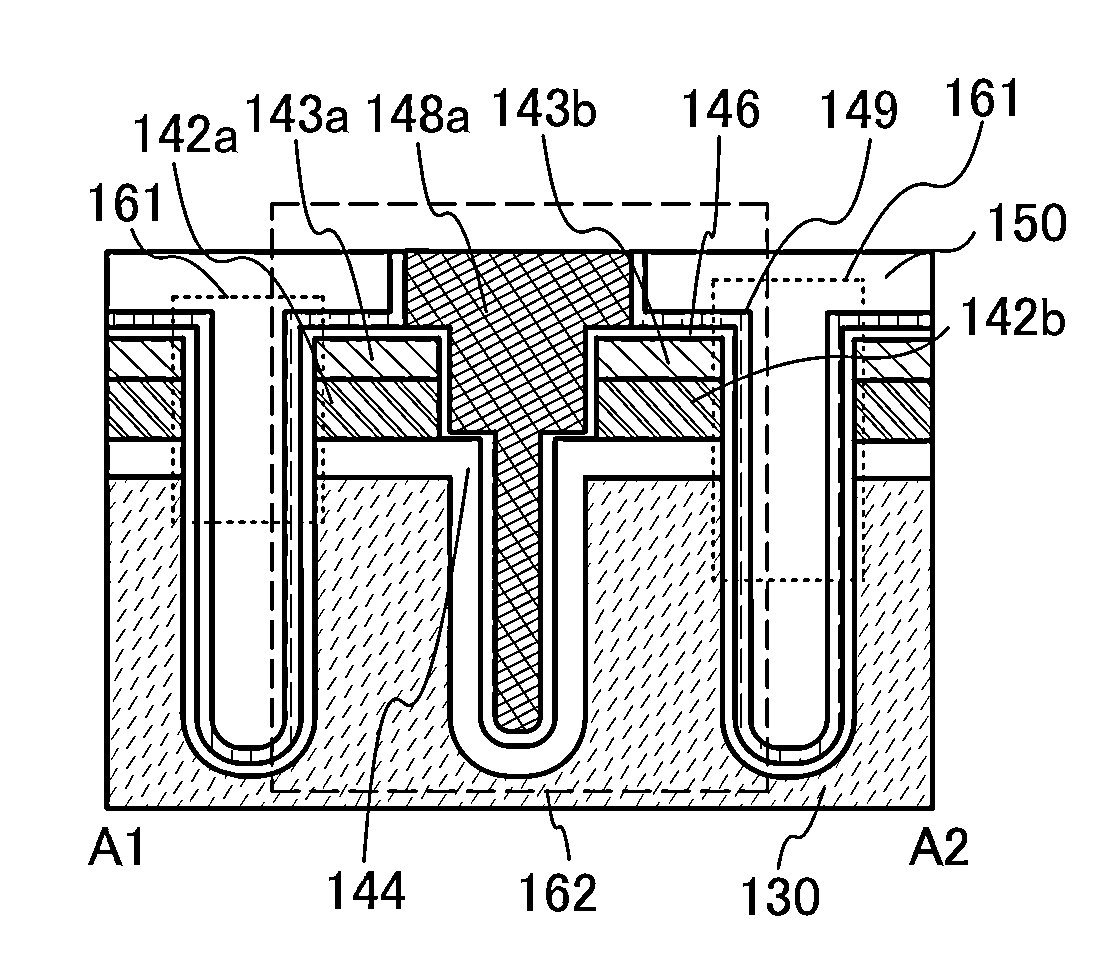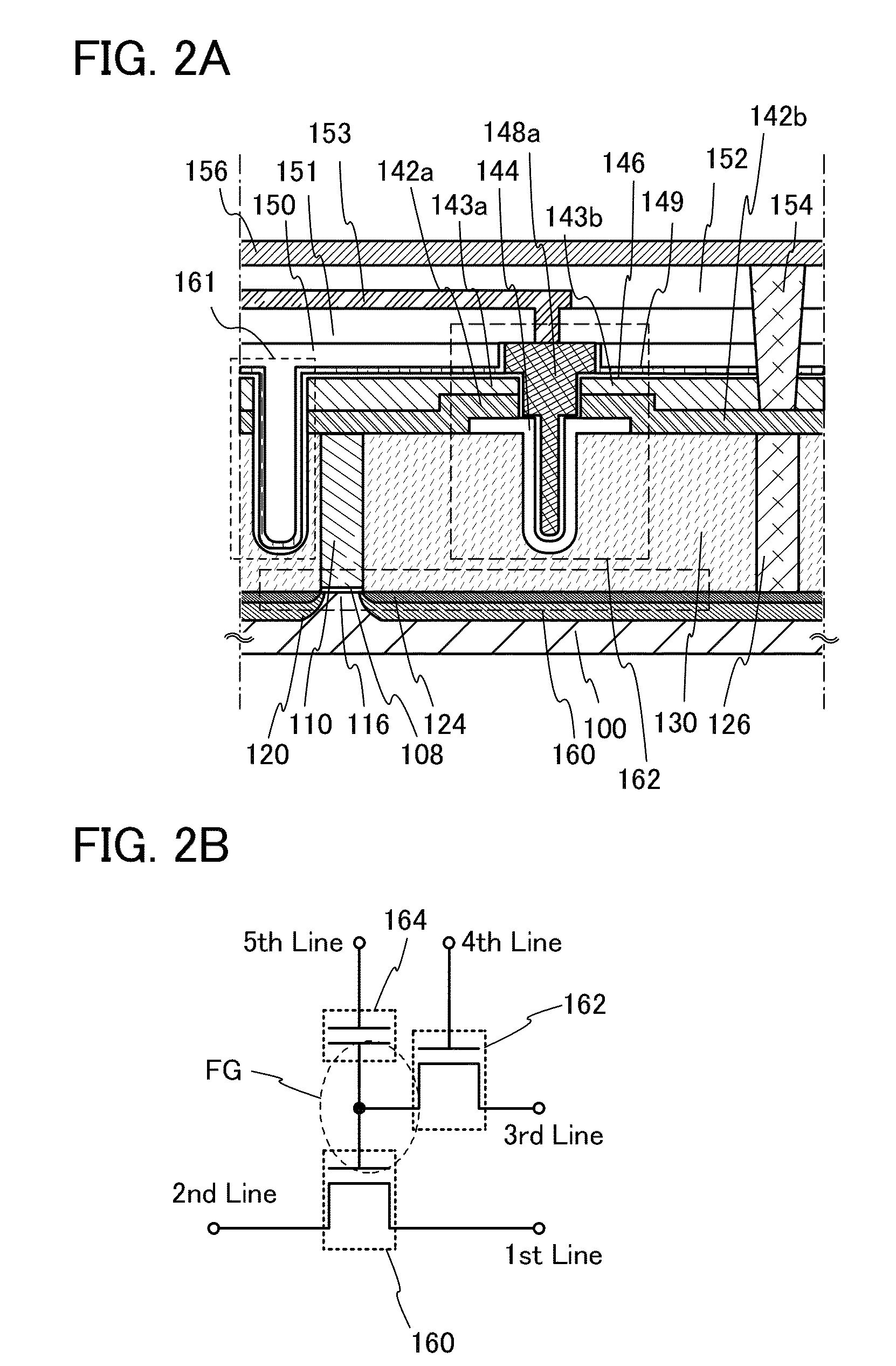Semiconductor device with a wide-gap semiconductor layer on inner wall of trench
a technology of semiconductor memory devices and trenches, which is applied in the direction of semiconductor devices, capacitors, electrical appliances, etc., can solve the problems of large power consumption, deterioration of transistors, and significant problems, and achieve the effect of reducing power consumption, suppressing short-channel effects, and improving data retention characteristics of semiconductor memory devices
- Summary
- Abstract
- Description
- Claims
- Application Information
AI Technical Summary
Benefits of technology
Problems solved by technology
Method used
Image
Examples
embodiment 1
(Embodiment 1)
[0036]In this embodiment, a structure of a transistor and a method for manufacturing the transistor according to one embodiment of the present invention will be described with reference to FIGS. 1A to 1C. FIG. 1A is an example of a cross-sectional view of a transistor 162 in a channel-length direction. FIG. 1B is an example of a cross-sectional view of an element isolation region 165 between the transistor 162 and a transistor 163. FIG. 1C is an example of a top view of the transistor 162 and the transistor 163. Note that FIG. 1B is part of a cross-sectional view of the transistor 162 in a channel-width direction, and corresponds to a cross-sectional view taken along a dotted line D1-D2 in FIG. 1C. FIG. 1A corresponds to a cross-sectional view taken along a dotted line A1-A2 in FIG. 1C.
[0037]First, an insulating layer 130 is formed with an oxide film over a semiconductor substrate. Then, a plurality of trenches (also referred to as grooves) is formed in the insulating ...
embodiment 2
(Embodiment 2)
[0094]FIGS. 2A and 2B illustrate an example of a semiconductor device which includes the transistor 162 illustrated in FIGS. 1A to 1C, which can hold stored data even when not powered, and which has an unlimited number of write cycles.
[0095]Since the off-state current of the transistor 162 is small, stored data can be held for a long time owing to such a transistor. In other words, the frequency of refresh operation can be extremely lowered, which leads to a sufficient reduction in power consumption.
[0096]FIG. 2A illustrates an example of a cross section of the semiconductor device.
[0097]The semiconductor device illustrated in FIG. 2A includes a transistor 160 including a first semiconductor material in a lower portion, and a transistor 162 including a second semiconductor material in an upper portion. The transistor 162 is the same as that in Embodiment 1; thus, for description of FIGS. 2A and 2B, the same reference numerals are used for the same parts as those in FIG...
embodiment 3
(Embodiment 3)
[0113]In this embodiment, a semiconductor device which includes the transistor 162 illustrated in FIGS. 1A to 1C, which can hold stored data even when not powered, which has an unlimited number of write cycles, and which has a structure different from the structure described in Embodiment 2 will be described with reference to FIG. 3.
[0114]The semiconductor device illustrated in FIG. 3 includes a transistor 350 including a first semiconductor material in a lower portion, and a transistor 162 including a second semiconductor material in an upper portion. Although a plurality of transistors is formed using semiconductor materials in the upper and lower portions, the transistor 350 and the transistor 162 will be typically described. Note that FIG. 3 which is taken along line B1-B2 corresponds to a cross-sectional view perpendicular to the channel-length direction of transistors.
[0115]Here, the first semiconductor material and the second semiconductor material are preferabl...
PUM
 Login to View More
Login to View More Abstract
Description
Claims
Application Information
 Login to View More
Login to View More - R&D
- Intellectual Property
- Life Sciences
- Materials
- Tech Scout
- Unparalleled Data Quality
- Higher Quality Content
- 60% Fewer Hallucinations
Browse by: Latest US Patents, China's latest patents, Technical Efficacy Thesaurus, Application Domain, Technology Topic, Popular Technical Reports.
© 2025 PatSnap. All rights reserved.Legal|Privacy policy|Modern Slavery Act Transparency Statement|Sitemap|About US| Contact US: help@patsnap.com



